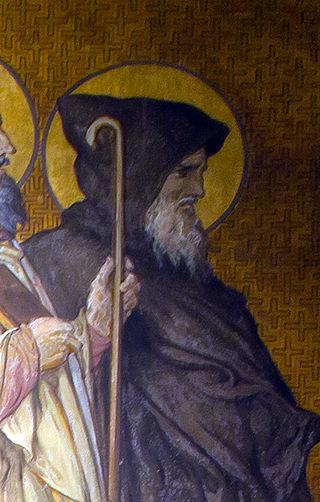
Aaron of Aleth, also called Saint Aihran or Eran in Breton, was a hermit, monk and abbot at a monastery on Cézembre, a small island near Aleth, opposite Saint-Malo in Brittany, France. Some sources suggest he may have migrated from Celtic Britain to take up residence in Armorican Domnonia.
Aaron was a Miaphysite Coptic saint. His apocryphal legend says of him, "When he was sick, he made roasted pigeons fly into his mouth." He has a feast in the Coptic Calendar of saints on May 16.
Aaron of Auxerre was a bishop of Auxerre. His relics are venerated in the Church of Saint-Germain in Auxerre, where his feast day is celebrated on 28 September.
Abadir and Iraja are saints in the Coptic Church and the Roman Catholic Church.
Abadiu of Antinoe was a bishop of Antinoe in the Fourth Century. He is commemorated as a saint in the Coptic Orthodox Church, and is said to have been killed in a theological dispute with the Arians. His feast day is 26 December. He is referenced in Les Martyrs d'Égypte by Hippolyte Delehaye.
Hor and Susia are martyrs of the Coptic Church. They were martyred with their sons Hor and Agatho. Their feast day is October 5.
SaintKragon was a robber converted to Christianity. He was a reformed robber and bandit. He died as a martyr in Alexandria and was buried at Pineban. His feast day is July 19. He is referenced in Les Martyrs d'Égypte by Hippolyte Delehaye.
Psote, also known as Bisada, Besada, Abashadi, Abassadius, or Beshada, was a bishop of Ebsay in Upper Egypt. He was martyred by beheading at Antinoe.
Abel of Tacla Haimonot was a monk at the monastery of Tacla Haimonot. He is considered a saint of the Coptic Orthodox Church, and has a feast day of July 13.
Abias is a saint of the Coptic Church. He is included in the Heiligen-Lexicon by J. E. Stadler. A church in Alexandria is dedicated in his name. It is unknown what his feast day was if he ever had one.
Abib and Apollo were two Christian ascetics from Akhmim, Egypt. They are mentioned in the Synaxarion, das ist der Heiligen-Kalendar der Koptischen Christen. Their feast day is celebrated on November 4.
Sabinus of Hermopolis was a procurator, possibly bishop, and Christian martyr of Hermopolis in Egypt.
Eugenius, Eugander, and Abilandius are saints of the Coptic Church. Their feast day is held on March 10.
Abnodius is a saint of Ethiopia (Abyssinia). He is venerated in the Coptic Church on 3 September.
Aprax is a saint of the Coptic Church.
Abraham of Scetes was a monk who became a saint of the Coptic Church.
James of Manug was a Christian martyr.
Abba Hor, Besoy, and Daydara were Christian martyrs in Egypt in the fourth century.
Abulak is a martyr and saint of the Coptic Church.
Wetzer and Welte's Kirchenlexikon is an encyclopedic work of Catholic biography, history, and theology, first compiled by Heinrich Joseph Wetzer and Benedict Welte. The first edition in 12 volumes was published from 1847 to 1860, by Verlag Herder.
